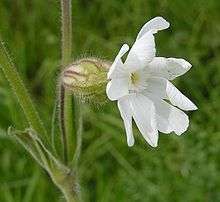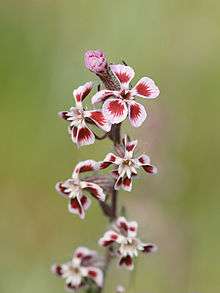Silene
| Silene | |
|---|---|
 | |
| Silene latifolia (white campion) | |
| Scientific classification | |
| Kingdom: | Plantae |
| (unranked): | Angiosperms |
| (unranked): | Eudicots |
| (unranked): | Core eudicots |
| Order: | Caryophyllales |
| Family: | Caryophyllaceae |
| Genus: | Silene L. |
| Species | |
|
About 300 species, see text. | |
| Wikimedia Commons has media related to Silene. |
Silene is a genus of flowering plants in the family Caryophyllaceae. Containing approximately 700 species, it is the largest genus in the family.[1] Common names include campion (which is shared with the related genus Lychnis) and catchfly. Many Silene species are widely distributed, particularly in the northern hemisphere.[1]
Etymology
Silene is the feminine form of Silenus, a Greek woodland deity.[2]
Uses
Silene undulata (syn. S. capensis) is known as undlela ziimhlophe ("white paths") by the Xhosa of South Africa. A Xhosa diviner identifies and collects the plant from the wild. The roots are ground, mixed with water, and beaten to a froth, which is consumed by novice diviners during the full moon to influence their dreams. They also take it to prepare for various rituals. The root has such a strong, musky essence that the diviners who consume it exude the scent in their sweat.[3]
Scientific history
Silene was originally described by Linnaeus, and members of this genus have been the subject of research by preeminent plant ecologists, evolutionary biologists, and geneticists, including Charles Darwin, Gregor Mendel, Carl Correns, Herbert G. Baker, and Janis Antonovics. Many Silene species continue to be widely used study systems, particularly in the fields of ecology and evolutionary biology.[4] The genus has been used as a model for understanding the genetics of sex determination for over a century. Silene species commonly contain a mixture of hermaphroditic and female (or male-sterile) individuals (gynodioecy), and early studies by Correns showed that male sterility could be maternally inherited,[5][6] an example of what is now known as cytoplasmic male sterility. Two independent groups of species in Silene have evolved separate male and female sexes (dioecy) with chromosomal sex determination that is analogous to the system found in humans and other mammals.[7][8] Silene flowers are frequently visited by flies, such as Rhingia campestris.[9] Silene species have also been used to study speciation, host-pathogen interactions, biological species invasions, adaptation to heavy-metal-contaminated soils, metapopulation genetics, and organelle genome evolution.[4] Notably, some members of the genus Silene hold the distinction of harboring the largest mitochondrial genomes ever identified.[10]
Selected species
If the related genera Lychnis, Melandrium, and Viscaria are included in Silene, it contains about 700 species.[1] Divisions of the genus into subgenera or sections before 2003 do not seem to be well-supported by molecular evidence.[1]
Species include:
- Silene acaulis (moss campion)
- Silene alexandri (Kamalo Gulch catchfly)
- Silene antirrhina (sleepy catchfly)
- Silene aperta (naked catchfly)
- Silene armeria (Sweet William catchfly)
- Silene bernardina (Palmer's catchfly)
- Silene biafrae
- Silene bridgesii (Bridges' catchfly)
- Silene caliacrae
- Silene campanulata (Red Mountain catchfly)
- Silene capensis (large-flowered catchfly, gunpowder plant, wild tobacco[11])
- Silene caroliniana (wild pink)
- Silene caucasica
- Silene colorata
- Silene conica (sand catchfly)
- Silene conoidea (weed silene)
- Silene coronaria (rose campion)
- Silene dichotoma (forked catchfly)
- Silene diclinis
- Silene dioica (red campion)
- Silene douglasii (Douglas' catchfly)
- Silene fernandezii
- Silene fraudatrix (North Cyprus catchfly)
- Silene gallica (small-flowered catchfly)
- Silene gazulensis
- Silene grayi (Gray's catchfly)
- Silene hawaiiensis (Hawaii catchfly)
- Silene hicesiae
- Silene hookeri (Hooker's silene)
- Silene horvati (Horvats's catchfly)[12]
- Silene invisa (red fir catchfly)

- Silene italica (Italian catchfly)
- Silene laciniata
- Silene laevigata (Troödos catchfly)
- Silene lanceolata (Kauai catchfly)
- Silene latifolia (white campion)
- Silene lemmonii (Lemmon's catchfly)
- Silene linicola (flaxfield catchfly)
- Silene maritima syn. Silene uniflora (sea campion)
- Silene marmorensis (Marble Mountain catchfly)
- Silene menziesii (Menzies' campion)
- Silene multinervia (manynerve catchfly)
- Silene noctiflora (night-flowering catchfly)
- Silene nuda (western fringed catchfly)
- Silene nutans (Nottingham catchfly)
- Silene occidentalis (western catchfly)
- Silene oregana (Oregon silene)
- Silene otites (Spanish catchfly)
- Silene ovata (ovate-leaved catchfly)[13]
- Silene paeoniensis (Paeonian catchfly)[14]
- Silene parishii (Parish's catchfly)
- Silene parryi
- Silene perlmanii (cliff-face catchfly)
- Silene polypetala (eastern fringed catchfly)
- Silene prilepensis (Prilep catchfly)[12]
- Silene regia (royal catchfly, showy catchfly)
- Silene rotundifolia (roundleaf catchfly)
- Silene rupestris (rock campion)
- Silene salmonacea (Klamath Mountain catchfly)
- Silene sargentii (Sargent's catchfly)
- Silene schafta (autumn catchfly)
- Silene scouleri (simple campion)
- Silene seelyi
- Silene sennenii
- Silene serpentinicola (serpentine Indian pink)
- Silene sorensenis (Sorensen's catchfly)
- Silene spaldingii (Spalding's silene)
- Silene stellata (starry campion)
- Silene stenophylla (narrow-leafed campion)
- Silene suecica
- Silene suksdorfii (Suksdorf's silene)
- Silene taimyrensis (Taymyr catchfly)
- Silene tomentosa
- Silene undulata
- Silene uniflora (sea campion)
- Silene vallesia
- Silene verecunda (San Francisco campion)
- Silene villosa
- Silene virginica (fire pink)
- Silene viscaria (sticky catchfly)
- Silene viscariopsis (Mariovo catchfly)[15]
- Silene viscosa (white sticky catchfly)
- Silene vulgaris (bladder campion)
- Silene wahlbergella (northern catchfly)
References
- 1 2 3 4 "36. Silene Linnaeus". Flora of North America.
- ↑ Quattrocchi, U. CRC World Dictionary of Plant Names. 1999. 4: 2482. ISBN 0-8493-2678-8
- ↑ Hirst, M. (2005). Dreams and medicines: The perspective of Xhosa diviners and novices in the Eastern Cape, South Africa. Indo-Pacific Journal of Phenomenology 5(2) 1-22.
- 1 2 Bernasconi et al. 2009. Silene as a model system in ecology and evolution. Heredity. 103:5-14. PMID 19367316
- ↑ Correns C. 1906. Die vererbung der Geshlechstsformen bei den gynodiocischen Pflanzen. Ber. Dtsch Bot. Ges. 24: 459–474.
- ↑ Correns C. 1908. Die rolle der mannlichen Keimzellen bei der Geschlechtsbestimmung der gynodioecishen Pflanzen. Ber. Dtsch Bot. Ges. 26A: 626–701.
- ↑ Evolution of Sex Chromosomes: The Case of the White Campion. PLoS Biol 3(1): e28. doi:10.1371/journal.pbio.0030028
- ↑ Mrackova M. et al. 2008. Independent origin of sex chromosomes in two species of the genus Silene. 179(2): 1129–1133. PMID 18558658
- ↑ Van Der Kooi, C. J.; Pen, I.; Staal, M.; Stavenga, D. G.; Elzenga, J. T. M. (2015). "Competition for pollinators and intra-communal spectral dissimilarity of flowers" (PDF). Plant Biology. doi:10.1111/plb.12328.
- ↑ Sloan DB et al. 2012. Rapid Evolution of Multichromosomal Genomes in Flowering Plant Mitochondria with Exceptionally High Mutation Rates. PLoS Biol. 10: e1001241. doi:10.1371/journal.pbio.1001241
- ↑ Silene undulata Aiton. SANBI Red List of South African Plants.
- 1 2 Country Study for Biodiversity of the Republic of Macedonia (First National Report). Skopje: Ministry of Environment and Physical Planning. 2003. ISBN 9989-110-15-8.
- ↑ United States Department of Agriculture (2011). "Silene ovata Pursh". USDA Plants Website. Retrieved 2011-11-18.
- ↑ Royal Botanic Garden Edinburgh (2001). "Silene paeoniensis". Flora Europaea Website. Retrieved 2010-08-27.
- ↑ "List of rare, threatened and endemic plants in Europe (1982 edition)". COUNCIL OF EUROPE. Retrieved 2010-08-27.
Further reading
- Pink, A. (2004). Gardening for the Million. Project Gutenberg Literary Archive Foundation.
External links
| Wikispecies has information related to: Silene |

